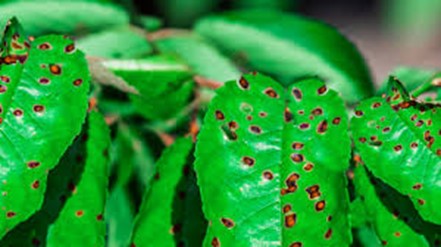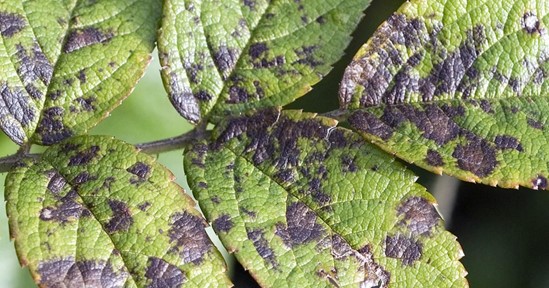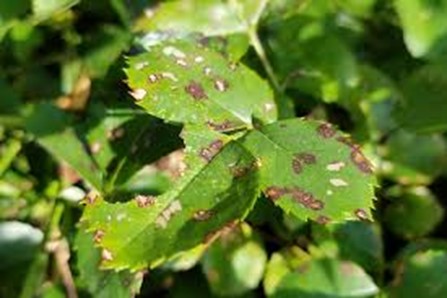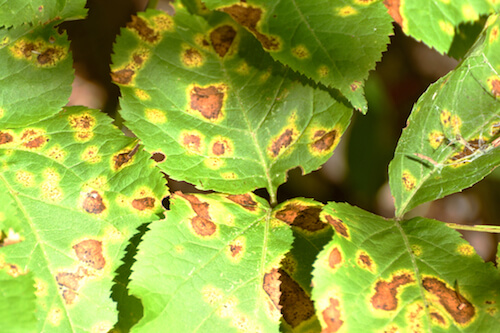You do not need to be a gardening enthusiast or an expert to have noticed the brown spots on leaves that they often develop. The tiny specs of brown on the otherwise green leaves are a sign of unhealthy leaves.
If the plants belong to you, then we are sure you would want to know the reasons behind these spots and how you can treat them.
So, in this detailed guide, we will talk about what does the presence of these brown spots on leaves mean, how you can treat them, and what measures you should take to prevent them from happening in the first place.
What Does It Mean If You Find Brown Spots on Leaves of The Plants in Your Garden?

There could be three reasons behind the brown spots on leaves. Most often, it is a fungal infection. Sometimes, it can also be caused by a bacterial invasion, and sometimes, certain insects mimic the leave spotting disease.
Generally, it is not a matter of concern, and you do not need to worry or do anything about it. It is a prevalent plant disease, and most often, the plants themselves are immune enough to protect themselves and heal naturally. Still, if you see a dramatic change in your plant’s health, a sharp increase in the number of brown spots on the leaves of the plants, or if the leaves have started to droop and fall at a rapid rate, then you might want to dig deeper into the matter.
If you want to go deeper into the cause, let us first talk about the types of fungi that causes the brown spots on leaves. The two most common fungal pathogens that cause the leave spotting disease are- Alternaria alternata and Cercospora species.
In case of an infection by Alternaria alternata, first, you will find small spots water-soaked spots on the leaves. They are most likely to target the older and lower leaves first. After some time, the watery texture is replaced by deep sunken brown spots that sometimes have a yellow halo.
The spots caused by these pathogens may or may not have concentric rings as they are often seen in leave spot diseases. In severe invasion cases, it can lead to leaves falling off chronically and at a high rate. Generally, this condition caused by this pathogen is catalyzed when the plant is not kept at a proper temperature or it is stored in a tight, closed box during transportation and shipping.
The disease caused by Cercospora species has different symptoms. It starts with light green spots that are a little sunken, which turn dark as they mature, often grayish or brown. These spots often have purple rings surrounding them, and as the spots mature, the center of the spot becomes raised, and as discussed earlier, even in this case, if the condition reaches a severe stage, it might lead to the leaves falling off.
Apart from this, common leave spot diseases are – Venturia, Cedar-Apple rust, and Septoria. They mainly differ in the texture and color of the spots.
Septoria has round spots with black rings surrounding it, Venturia has brown-black spots, while Cedar-Apple rust produces clusters of brown spots.
All these 3 leads to the death of the leave and even the entire plant if precautions are not taken on time.
What Are the Symptoms That You Will Find?

There are three types of symptoms that you will see because, to treat the issue, you will need to understand and get to the exact cause of the problem, right?
Multiple brown spots both on the top and the underside of the leave are common. They would in large numbers spread all over the leaves’ green surface, sometimes sunken, sometimes a little raised, sometimes they have concentric rings, sometimes they do not, but what do these different symptoms mean? And how will you distinguish between them and find out the real cause behind the brown spots on leaves? There is a straightforward trick.
If the leaves’ spots look like they are not a part of it, i.e., if they look like specs of dirt that can be removed by blowing it off, then the infection is appropriately caused by mites, leaves, mealybugs, whiteflies, or scales.
In case you see that the brown spots on leaves look like they are a part of the leave structure, they look a little raised from the surface with a soft, watery texture. Your plant might have been exposed to too much sunlight or excess manganese through the fertilizers, or maybe too much water retention or a pH imbalance.
There is a third possibility when it comes to brown spots on leaves. If the spots appear only on the underside of your leave and have a dry shiny texture, then most likely, the leaves are suffering from a condition called leaf thrips or nematodes.
How Can You Treat This Condition of Brown Spots on Your Leaves?

Generally, the plants are capable of healing and protecting themselves from these diseases on their own. What happens is that the infected leaves fall off and are replaced by the fresh ones without the spots.
But if this becomes a ritual, leaves developing brown spots then falling off and getting replaced by new leaves, which again develops spots more than 3 to 4 years in a row. It is a matter of concern because the disease has severely impacted your plant or tree.
However, you do not need to worry because there are ways to treat brown spots on leaves and prevent the further spreading of the infection. We will now discuss how you can prevent the spread of the infection to the other healthy leaves and treat the condition.
Get Rid of The Infected Leaves
While this is not a cure, this should be one of the first things you do once the plants’ leaves develop the spots. This will prevent the infection from spreading to your other healthy leaves. It is essential that you cut off the infected part as soon as possible.
If you are dealing with a tall tree, it is highly recommended that you consult an expert. If you are an amateur, please do not try climbing up the tree alone. Talk to an expert, and that person will help you cut off all the dead and infected parts of the tree to help it return to its healthy natural state.
Try to Keep Your Leaves Dry
It is not in your hand during the monsoon or a heavy downpour, but once you notice brown spots on leaves, you should do all you can to keep them dry and away from water. Most often, while watering plants, we tend to sprinkle some waters all the leave as well.
Do not do that. Just water the roots in the amount required by the plant (avoid excess watering at all costs). Sprinkling water on the leaves will worsen the condition and spread the infection to the neighboring healthy leaves.
Protect Your Tree and Keep It Healthy
When your plant or tree is recovering from the disease, your tree is in a fragile state, just like humans. In a vulnerable state like that, your plant is very prone to develop the disease again, and there are higher chances of pest invasion and other kinds of plant diseases.
So, in a state when your plant is not capable of taking care of itself and healing naturally, you will have to take extra care. Ensure that they get enough nutrition, water them properly, and make sure that they are not over-exposed to sunlight. In the slightest case of brown spots on leaves being developed once again or invasion by pests and mites, take immediate action.
Take Help of a Fungicide
Although this is not the most recommended option, if you are left with no other choice, you should consider taking the help of a fungicide. They will protect your tree from further damage and infection and keep away all the pests and bacteria away. However, if you are not an expert, then you should conduct this process under expert supervision.
If the right kind of fungicide is not used in the right amount, then wither it will not affect at all (if the amount used is less), or it will damage your already weak tree (if the amount is way too much). So, in either case, your tree is at a disadvantage. So, consult an expert, ask them what you should use and in what quantity and how often and for how long before you go forward with this process.
Avoid Overcrowding
When you plant new plants or trees, you often misjudge the space needed once it matures completely. That leads you to plant several plants at a closer distance, and when they grow, it leads to overcrowding. This is one of the biggest reasons your plant’s health deteriorates, and it develops brown spots on leaves.
So, to make sure that your plant maintains its health, you need to plant them at proper distances so that once they grow up, they can get an adequate amount of water, sunlight, and nutrition from the soil. It also ensures that if one tree is infected, the other trees do not get the infection.
Get Rid of The Junk
A crucial point that a lot of gardeners miss. Your plants and trees require regular trimming. Cut off the dead branches and removes the withered leaves. Get rid of the infected once. To maintain your plant’s overall health, you need to get rid of what has already gone bad.
When you trim and cut off the dead parts, you are not just making space for new growth. You are also getting a close look at your plant that will help you know whether your plant has any disease or not beforehand.
How to Prevent Brown Spots on Leaves?
We have talked about how we can treat the brown spots on leaves and prevent the infection from spreading to the healthy parts of the plant or tree. But now, let us talk about how we can prevent the brown spots on leaves from appearing in the first place.
The preventive measures are not that different from the prevention methods. It would help if you kept a few things in mind.
- Water the roots, not the leaves. Whether your plant already has the disease or a healthy plant, do not water the leaves. If you water them today, wait for the soil to dry up before you again water them tomorrow.
- Trim and prune your plants as and when required. Remove the dead old stems and leaves, make space for the new ones, and get rid of the diseased leaves as soon as possible because this is a significant factor in determining your plant’s health.
- Another essential benefit of pruning is that it improves air circulation. Better air circulation will keep your plant healthy.
- The last point is to use fungicides. In case your garden is severely infested by pests or any pathogen infection, this is the best way to protect your garden and improve its health.
So, this was everything you needed to know about the brown spots on leaves, why they happen, how you can prevent that, and how you can treat the condition.
However, even after all these efforts, if your plant keeps developing the spots year after year, it has reached a very critical stage of the disease, and it will not get any better.
In that case, you need to give up and protect your other plants from the infection.
We hope that this detailed guide was helpful to you and all your queries were answered. If you have any further questions, do not be shy to reach out to us in the comment section below.

